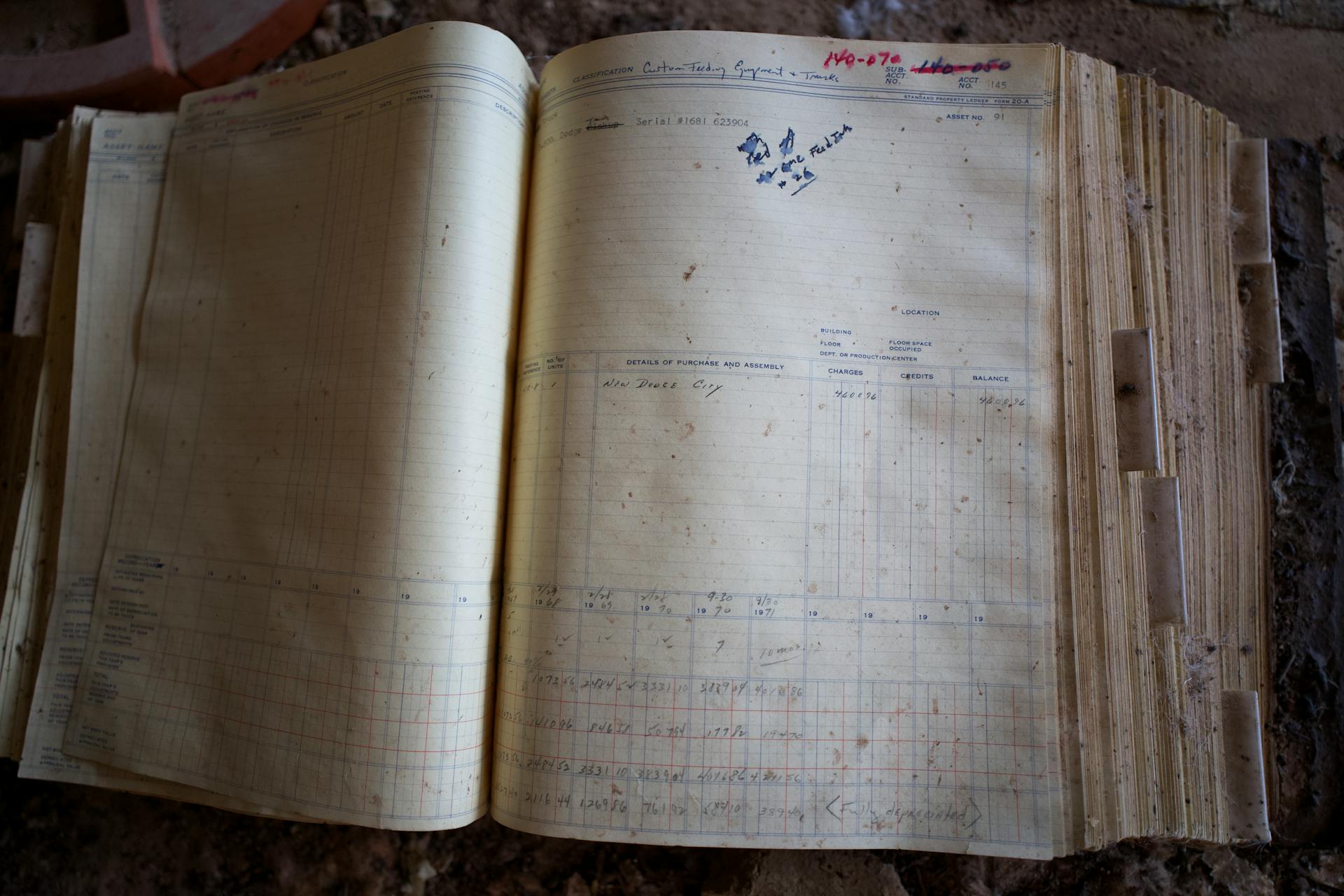
Accumulated depreciation and depreciation expense are two related but distinct concepts in accounting.
Accumulated depreciation is a balance sheet account that represents the total amount of depreciation expense recorded over the life of an asset.
Depreciation expense, on the other hand, is a recurring expense recorded in the income statement to reflect the decrease in an asset's value over time.
The key difference between accumulated depreciation and depreciation expense is that accumulated depreciation is a historical record of depreciation expenses, while depreciation expense is the current year's expense.
What Is Accumulated Depreciation?
Accumulated depreciation is a running total of all the depreciation expenses a business has recorded over its lifetime. It's a crucial concept in accounting, but it's often confused with depreciation expense.
Depreciation expense is the amount of depreciation recorded in a single accounting period, usually a year. For example, if a company records $10,000 in depreciation expense for a piece of equipment in year one, that's the depreciation expense for that year.
Readers also liked: What Is Prior Year Accumulated Depreciation
Accumulated depreciation, on the other hand, is the total depreciation recorded over multiple years. In our example, if the company records $5,000 in depreciation expense for the same equipment in year two, the accumulated depreciation would be $15,000 ($10,000 + $5,000).
Accumulated depreciation is typically reported on the balance sheet, while depreciation expense is reported on the income statement.
Recommended read: Accumulated Depreciation Is Reported on the
Types of Depreciation Methods
There are two main types of depreciation methods: straight-line and accelerated depreciation. The straight-line method gradually reduces the carrying balance of the fixed asset over its useful life, with the annual depreciation calculated by dividing the depreciable amount by the number of years in the asset's useful life.
The straight-line method is the easiest way to calculate accumulated depreciation, and it's often preferred by companies for GAAP reporting purposes. This is because lower depreciation is recorded in the earlier years of the asset's useful life, resulting in higher net income and EPS in the initial years.
Suggestion: Straight Line Depreciation vs Accelerated
The accelerated depreciation method, on the other hand, reduces the carrying balance of a fixed asset more in earlier periods, resulting in lower net income and EPS in the earlier years. However, companies tend to prioritize near-term earnings performance, which is why straight-line depreciation is often preferred.
Here's a comparison of the two methods:
The straight-line method is often preferred by companies, but the accelerated method can be useful for assets that receive the most use when they're new, such as electronic equipment or vehicles.
For another approach, see: Depreciation Expense Straight Line Method
Straight Line
The straight-line method is one of the most common types of depreciation methods. It gradually reduces the carrying balance of a fixed asset over its useful life.
To calculate the annual depreciation using the straight-line method, you need to know the purchase price, salvage value, and useful life of the asset. For example, if a company purchases a machine for $30,000 with a salvage value of $5,000 and a useful life of 10 years, the annual depreciation would be $2,500.
Discover more: Macrs Depreciation vs Straight Line
The formula for calculating annual depreciation is: Annual Depreciation = (Purchase Price - Salvage Value) / Years in Useful Life. In this case, the annual depreciation would be $2,500, meaning the asset depreciates $2,500 each year.
To calculate monthly depreciation, simply divide the annual total by 12. For example, if the annual depreciation is $2,500, the monthly depreciation would be approximately $209.33.
The straight-line method is often preferred by companies because it allows for lower depreciation in the earlier years of the asset's useful life, resulting in higher net income and earnings per share (EPS) in the initial years.
Here's a summary of the straight-line method formula:
- Purchase Price: $30,000
- Salvage Value: $5,000
- Useful Life: 10 years
- Annual Depreciation: ($30,000 - $5,000) / 10 = $2,500
- Monthly Depreciation: $2,500 / 12 = approximately $209.33
Units of Production
The units of production method is a depreciation approach that takes into account the perceived usage, or "wear and tear", of a fixed asset.
This method is technically the most accurate, but it's also the most tedious and requires a granular analysis, including per-unit tracking, making it quite time-consuming.
To use this method, you need to track the usage of each asset, which can be a challenge, especially for complex assets.
The units of production method is not for the faint of heart, as it demands meticulous record-keeping and attention to detail.
It's worth noting that this method is often considered the most accurate, but its complexity makes it less practical for everyday use.
Calculating Depreciation Expense
Calculating depreciation expense is a crucial step in accounting for fixed assets. There are three common methods to calculate depreciation: Straight-Line Depreciation Method, Declining Balance Depreciation Method (DDB), and Units of Production Depreciation Method.
The Straight-Line Method is the simplest method, where the depreciation expense is calculated by dividing the cost of the asset by its useful life. For example, if a manufacturing company purchases $100k of PP&E with a useful life estimation of 5 years, the annual depreciation expense would be $20k.
The formula to calculate the annual depreciation is the remaining book value of the fixed asset recorded on the balance sheet divided by the useful life assumption. This formula can be extended for the remainder of the forecast, as shown in the example where the new Capex is $307k, which after dividing by 5 years, comes out to be about $61k in annual depreciation.
Explore further: Depreciation Expense Formula for Non Profit Organization
The depreciation expense is then recognized across the entire forecast period, which can be seen in the example where the depreciation expense of $10 million is recognized across the entire forecast of five years. By the end of Year 5, the ending PP&E balance is $50 million, representing the accumulated depreciation on the fixed asset.
The following table illustrates the calculation of depreciation expense using the Straight-Line Method:
Is an Expense?
Depreciation expense can be a bit tricky to understand, but it's actually quite straightforward. It's recognized as an operating cost on the income statement, either as part of the cost of goods sold (COGS) or operating expenses (Opex).
The recognition of depreciation on the income statement reduces taxable income, which in turn lowers net income. This is because depreciation is a non-cash item, meaning it doesn't involve a real outflow of cash.
Depreciation expense is treated as a non-cash add-back on the cash flow statement (CFS) since no real cash has been spent. This is an important distinction to make when reviewing a company's financial statements.
For another approach, see: Is Depreciation a Non Cash Expense
Companies seldom report depreciation as a separate expense on their income statement, so you might need to look at the cash flow statement or footnotes section to find the precise value of a company's depreciation expense.
Here are the common places where depreciation expense is reported:
- Cost of Goods Sold (COGS)
- Operating Expenses (Opex)
Remember, depreciation expense reduces the book value of a company's property, plant and equipment (PP&E) over its estimated useful life.
Calculating Formulas
The straight-line method is the most common method to calculate depreciation, where the annual depreciation is the remaining book value of the fixed asset divided by the useful life assumption.
This method is used in the example where a company purchases $100k of PP&E with a useful life estimation of 5 years, resulting in an annual depreciation of $20k.
The formula to calculate annual depreciation is: Depreciation Expense = (Remaining Book Value - Salvage Value) ÷ Useful Life Assumption.
This formula is used in the example where the salvage value is assumed to be zero, resulting in a depreciation expense of $10 million per year.
On a similar theme: Accumulation Value vs Cash Value
The formula to calculate accumulated depreciation is: Accumulated Depreciation = Annual Depreciation × Number of Years.
This formula is used in the example where the company purchases $100k of PP&E with a useful life estimation of 5 years, resulting in an accumulated depreciation of $100k.
Here are the common methods to calculate depreciation:
- Straight-line method
- Double-declining balance method
- Units of production method
These methods can be used to calculate accumulated depreciation, which is usually calculated from month to month.
The straight-line method uses the following formula: Accumulated Depreciation = (Cost - Salvage Value) × (1 - (1 + (1/n))^(-n)), where n is the number of years.
The double-declining balance method uses the following formula: Accumulated Depreciation = (Cost - Salvage Value) × (2/n), where n is the number of years.
Note: The formulas above are used in the examples provided, but may not be applicable to all situations.
Expand your knowledge: Formula for Depreciation Expense
How to Forecast
Forecasting depreciation is a crucial step in calculating the depreciation expense of a company. You can use the "quick and dirty" method to project capital expenditures (Capex) and depreciation.
To forecast Capex, use historical data as a reference point and consider management guidance and industry averages. This will give you a good idea of how much Capex to expect in relation to revenue.
Capex can be forecasted as a percentage of revenue, and depreciation can be projected as a percentage of Capex. In fact, depreciation is the reduction of the PP&E purchase value, which is the result of expensing Capex.
For mature businesses with low, stagnating, or declining growth, the depreciation to capex ratio converges near 100%. This means that most of the total Capex is related to maintenance Capex, which is the routine spending required for operations to continue.
Here are some key points to keep in mind when forecasting depreciation:
This will help you understand how to project depreciation in relation to Capex and revenue.
Frequently Asked Questions
Are accumulated depreciation and depreciation expense the same?
No, accumulated depreciation and depreciation expense are not the same, but they're closely related. Accumulated depreciation is the total of depreciation expenses over time, while depreciation expense is the annual cost of asset wear and tear.
What is an example of a depreciation expense?
Depreciation expense is calculated by dividing the asset's cost by its useful life, resulting in a fixed annual expense. For example, a $50 million building with a 25-year lifespan would have an annual depreciation expense of $2 million
Sources
- https://differbtw.com/difference-between-accumulated-depreciation-and-depreciation-expense/
- https://www.wallstreetprep.com/knowledge/depreciation/
- https://gocardless.com/en-us/guides/posts/what-is-accumulated-depreciation-formula/
- https://www.patriotsoftware.com/blog/accounting/what-is-accumulated-depreciation/
- https://www.wallstreetprep.com/knowledge/accumulated-depreciation/
Featured Images: pexels.com


